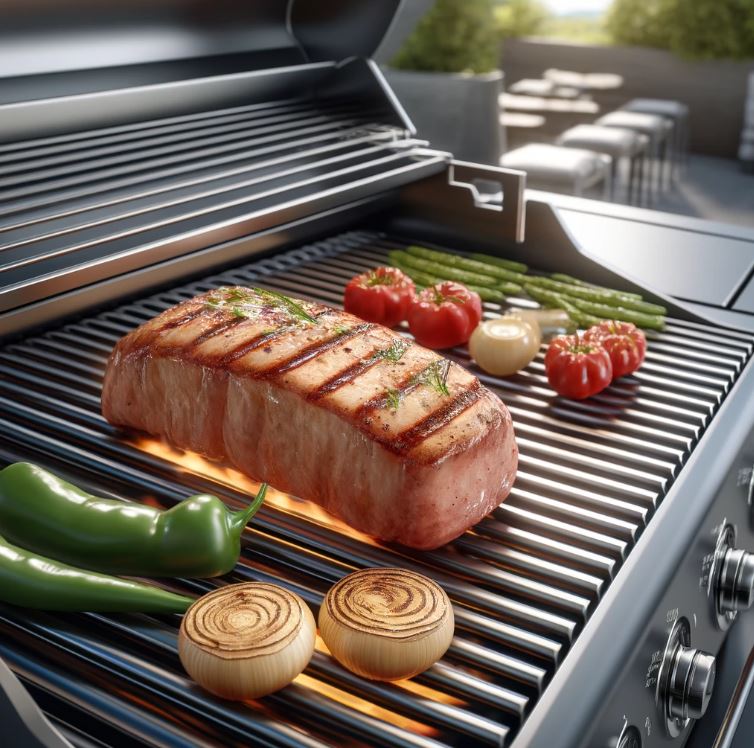I'm a participant in the Amazon Services LLC Associates Program, an affiliate advertising program designed to provide a means for me to earn fees by linking to Amazon.com and affiliated sites.
Cooking pork tenderloin on a gas grill using the 7-6-5 method is a foolproof way to achieve tender, juicy, and flavorful results. This method, named for its precise grilling times, is perfect for both novice and experienced grillers. In this guide, we’ll walk you through each step of the pork tenderloin on gas grill 7-6-5 method, ensuring your pork tenderloin is cooked to perfection every time.
Key Takeaways
- 7-6-5 Method: Grill pork tenderloin over direct heat for seven minutes, flip and grill for six minutes, then finish on indirect heat for five minutes.
- Season Generously: Use a robust dry rub or marinade and let the tenderloin rest at room temperature before grilling.
- Preheat the Grill: Ensure your grill reaches 450-500°F for optimal searing.
- Check Doneness: Use a meat thermometer to ensure the internal temperature reaches 145°F.
- Rest Before Serving: Allow the tenderloin to rest for 5-10 minutes after grilling to retain its juices.
Is your current gas grill up to the task of grilling pork tenderloin? If you’re not so sure, then you might want to mozy over to our best gas grills under $500 review to pick up a new model.
Understanding the 7-6-5 Method
What is the 7-6-5 Method?
The 7-6-5 method is a grilling technique specifically designed for pork tenderloin. It involves three distinct cooking stages:
- Seven Minutes: Grill the tenderloin over direct heat for seven minutes.
- Six Minutes: Flip the tenderloin and grill for another six minutes over direct heat.
- Five Minutes: Move the tenderloin to indirect heat, close the lid, and cook for five minutes.
This method ensures even cooking and helps maintain the tenderloin’s moisture and flavor.
Why Choose the 7-6-5 Method?
This method simplifies the grilling process by providing clear, timed steps. It reduces the risk of overcooking or undercooking, making it an excellent choice for achieving consistent results.
Preparing Your Pork Tenderloin
Selecting the Right Cut
Choose a fresh, high-quality pork tenderloin, ideally around 1 to 1.5 pounds. This size is perfect for the 7-6-5 method and ensures even cooking.
Seasoning
Generously season the pork tenderloin with a dry rub or marinade. A simple blend of salt, pepper, garlic powder, and paprika works well. For enhanced flavor, let the tenderloin marinate in the refrigerator for at least 30 minutes or overnight.
Bringing to Room Temperature
Before grilling, allow the pork tenderloin to sit at room temperature for about 30 minutes. This helps it cook more evenly.
Setting Up the Gas Grill
Preheating the Grill
Preheat your gas grill to high heat, around 450-500°F. A properly preheated grill ensures a good sear on the tenderloin, locking in juices.
Oil the Grates
Brush the grill grates with oil to prevent sticking. Use a high smoke point oil like canola or grapeseed oil.
Pork Tenderloin on Gas Grill: 7-6-5 Method
The 7-6-5 Method in Action
- First Seven Minutes: Place the pork tenderloin on the grill over direct heat. Close the lid and cook for seven minutes.
- Next Six Minutes: Flip the tenderloin and grill for an additional six minutes over direct heat with the lid closed.
- Final Five Minutes: Move the tenderloin to indirect heat, close the lid, and cook for five minutes.
Checking Doneness
Use a meat thermometer to check the internal temperature of the pork tenderloin. It should read 145°F for safe consumption. If it hasn’t reached this temperature, let it cook for a few more minutes on indirect heat.
Resting the Tenderloin
Remove the pork tenderloin from the grill and let it rest for about 5-10 minutes. Resting allows the juices to redistribute throughout the meat, ensuring a juicy and flavorful result.
Serving Suggestions
Classic Pairings
Serve your pork tenderloin with classic sides like grilled vegetables, mashed potatoes, or a fresh green salad.
Creative Ideas
For a gourmet touch, try pairing the tenderloin with a fruit salsa or a honey mustard glaze.
Recent Developments in Grilling Techniques
Grilling technology and techniques continue to evolve, providing new ways to enhance your grilling experience:
- Smart Grills: Modern gas grills now come with smart technology, allowing you to monitor and control the grill temperature via smartphone apps.
- Infrared Burners: These burners provide intense, even heat, perfect for achieving a good sear on meats.
- Eco-Friendly Fuels: Sustainable propane alternatives are gaining popularity, offering greener options for outdoor cooking.
Top Experts in the Field and Their Contributions
Steven Raichlen
Steven Raichlen, a renowned barbecue expert and author, emphasizes the importance of precise temperature control and seasoning in grilling pork tenderloin. His books and shows provide invaluable tips for achieving perfect results.
Link to Steven Raichlen: Steven Raichlen’s Barbecue Bible
Meathead Goldwyn
Meathead Goldwyn, founder of AmazingRibs.com, offers comprehensive guides on grilling techniques, including the 7-6-5 method. His insights on meat science and grilling methods are highly regarded in the barbecue community.
Link to Meathead Goldwyn: Amazing Ribs
Melissa Cookston
Melissa Cookston, a world-champion pitmaster, shares her expertise on grilling and smoking meats. Her tips on marinades and rubs are particularly useful for enhancing the flavor of pork tenderloin.
Link to Melissa Cookston: Melissa Cookston’s Official Site
For more grilling tips and recipes, check out our articles on Ninja FrostVault vs Igloo, Grill Dinner Ideas, and Leftover Grilled Chicken Ideas. If you’re looking for bold flavors, visit our guide on Craving Spicy Food. Also, explore the benefits of GLP-1 boosting foods for weight loss in our recent article on GLP-1 Weight Loss for Non-Diabetics.
Author
HappyFoodGeek
HappyFoodGeek is an expert in the field of grilling and outdoor cooking with years of experience. Dedicated to bringing the latest tips, techniques, and recipes, HappyFoodGeek aims to inspire and inform readers to achieve culinary excellence in their own backyards.
